
How the real history of New York informed the retro-futuristic setting and narrative of Aether & Iron
Several weeks ago, I got the chance to go hands-on and check out an upcoming narrative adventure RPG, Aether & Iron. It didn't take long for its hooks to get into me. Set in a retro-futuristic reimagining of New York, I took control of a smuggler named Gia and she was just about to go on her next big job.
The developers at Seismic Squirrel were certainly inspired in how Disco Elysium presented its narrative. Gia engages with her internal thoughts and her conversations with others in a series of skill checks that shape the actions and responses that she is willing, or unwilling, to take depending on the roll of the dice. Unlike Disco Elysium, Aether & Iron is navigatable in a more traditional adventure-style game as still scenery has certain objects of interest.
Luckily, there are nodes on these scenes that clearly depict what can be interacted with. The nodes will be lit up if they have yet to be checked or have new information for the player, and they'll be more faded away if they've already been checked. It leaves no guesswork, so there's no need to double check if you've missed anything on them.
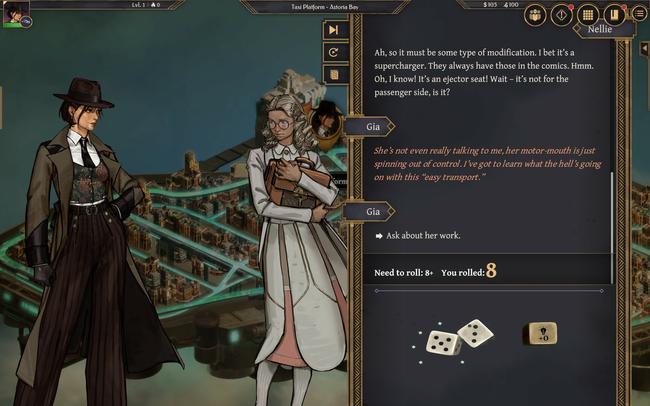
Part of my hands-on allowed me to briefly check out the battle system, which all took place inside a car. It almost adopts a strategy RPG approach as action points dictate how much your vehicle can move around the road "arena", as well as what attacks it has access to. Certain attack options required it to be in a certain position, such as ramming other enemy vehicles required them to be beside them. Another battle ability was only available when my vehicle was in front of an enemy, since it had my character shoot backwards.
Aether & Iron is a bit tricky to describe with text alone, so I highly recommend giving its free public demo on Steam a shot. The final release some time in 2026 aims to support full voice acting and what I've heard of it already sounded quite solid. What particularly caught my interest is the careful attention to its worldbuilding and I got the chance to speak to Aether & Iron's narrative lead Tyler Whitney on what it took to create Aether & Iron's version of New York. He had a lot to say and if what he says peaks your interest, be sure to check out the game's demo!
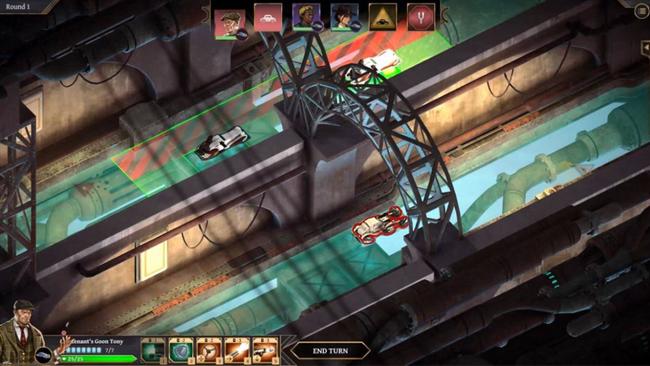
Tyler Whitney, Narrative Lead of Aether & Iron: When we first started the game, we knew we wanted to make a turn-based tactics game. We knew we wanted to do something different and were like… ok, let’s start with cars. The problem with cars - momentum; turn-based tactics are slow and difficult to show a moving background. Let’s play with this and see what we can do.
First off, what type of cars would we wanna do? Well, 30’s cars look awesome - but well, we can’t just do 30’s cars. That’s been done, right? Let’s make them fly. The design team looked over at me as the narrative lead and told me, “Make that make sense.” Ok, 1930’s cars that are flying… let’s build a world around that.
So, it kinda grew out of that. If the cars are flying in the 30’s, then why? There’s a material that allows it. When was that discovered? How did that affect the world? We have to do it in New York City because that’s the capital of noir-feeling. So, New York City gets this flying technology - how does that affect it? How does that change its politics, people, philosophy, idealogy, all these things. I was able to build a world based on that starting premise.
Whitney: The quick answer is we didn’t realize how challenging everything was going to be. I think… goodness, I don’t think there was anything that had me going “Ah, that was easy.” Every part of it was “Oh, this takes a lot; this takes more.” At least, that was from my perspective especially going into the noir setting of making the characters feel as if they’re part of that 1930’s pulpy setting in how they’re talking.
I don’t think we realized how much of a commitment we were planting our flag on. We wanted it to feel a certain way, so let’s just commit. Now we’re coming up to writing the last third of Aether & Iron and man, that was… that was an expensive commitment in terms of time, research, and effort. Writing through the script – you have to try and make everything beautiful and have emotional depth. I’m glad we did it. I think it was worth it and it panned out, but that’s just from the narrative side.
If we had the design team here, everything you’ve seen gameplay-wise has gone through multiple iterations – the traversal, the combat. At one point for the combat, we were thinking “What if… what if we tried Mario Kart?” Turns out – not the best prototype that we ended up making. What we have now is something you don’t see often with the turn-based tactics focused on car combat and the heavily narrative driven RPG side. That mixture took awhile to refine as we asked ourselves “What is this game?” and it took awhile to come together.
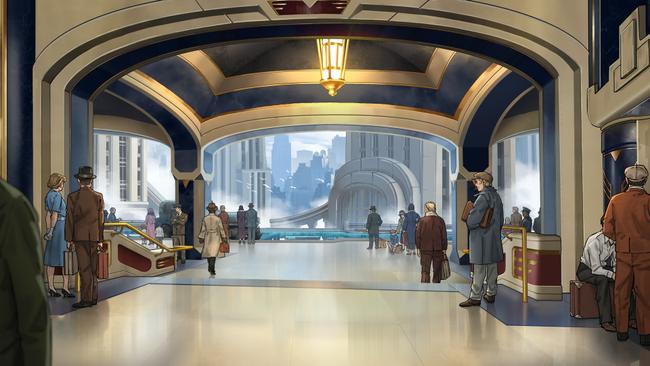
Whitney: When we were building out Aether & Iron’s world, the first thing we did was build out the world. What are the rules of this space? Who are the types of people, what are the things that they’re doing, and how do they interact? We built the general framework of that world.
My background is in history; if I have one sin, it’s that I get wrapped up in getting into a historical topic and getting lost in it. Every character and every location has some sort of historical analogue to New York City – and a lot of the characters you’ll come in contact with have this really deep, rich backlog to them. Following this use of history, what are some amazing characters – people – that lived at that time? How can we pull them in? How can we make something based off of them and honor them?
New York history is so much stranger than fiction more often than not. For example, there’s a character that you’ll meet in Aether & Iron that is in charge of this entire barony. He’s based off the guy who created the New York Department of Sanitation. His story was wild; I’ll give you the Sparks Notes version. In real life history, New York City management said that the city had too much trash. Let’s hire somebody that was in the military to figure it all out. So he comes along and creates what’s effectively a paramilitary group. He hires a whole bunch of big guys to put them in stark white uniforms, military helmets, and give them sturdy brooms. They have to clean New York City block-by-block; this group called themselves the White Wings. They had parades, along with their own resorts, and were backed by the President of the United States.
When we read that on the development side, we said, “That’s nuts. That’s crazy that happened. Let’s take that and use that to inspire a faction in our world.” Then, we got to build from there. So to go back to your question, we built the world first and then we built the characters. We realized that in order to really honor the history of the characters we were representing, a big part of that is trying our darndest in making our characters feel more than two dimensional – making sure we identify what is it that they want, they need, their character arc, their contribution to the world, and what is it that they’re connected to.
We tried to make some individual missions reflective of some character’s relationship to the world and in that way, they could be front and center so players could see who they are, where they came from, and why they exist. I think it allowed us to make a pretty in-depth world.
Whitney: One thing about New York is that it’s constantly building, expanding, and developing. That in turn, has economic forces and cultural forces constantly morphing it and changing it. When I was worldbuilding and putting it together, this aether material has been around since right after the American Civil War and it’s 1938 now. Our world wouldn’t be stagnant at that point in time, if aether existed. It’d be evolving.
What that meant for the map was that New York started building with this rudimentary technology. They built all these islands and they were built in a certain time at the land of the 19th century. Then technology developed even more. It grew, expanded, and people that were able to manipulate wealth and power also expanded. They utilized that technology and they rose higher. That process then continued for the third and final highest floating island.
The Heights are at the very top; that is more inspired by what people thought the future would be in 1938. There was the World Fair that had this grandiose idea of what the future would be – so that’s the upper echelon.
The Uppers are inspired by the Art Deco movement at the 20th century. Think of this as more of the middle class. Then we have the Lowers where a lot of Aether & Iron is set in. This is the first part of the city that was built; it has the most rudimentary and oldest technology, as well as 19th century architecture and 19th century ideas. The people here have a different type of power relationship.
All that to say when we built out this map and this world, take any area/location/city in the world with this aether material – it changes so much. I wanted to represent that divide because it feels honest and real. As you said with the portrayal of New York as a character, the worst characters are the ones that are the same – always and forever. If New York was going to be a good character, it needed to change and have a history of its own; it needs to have a trajectory and a character arc.
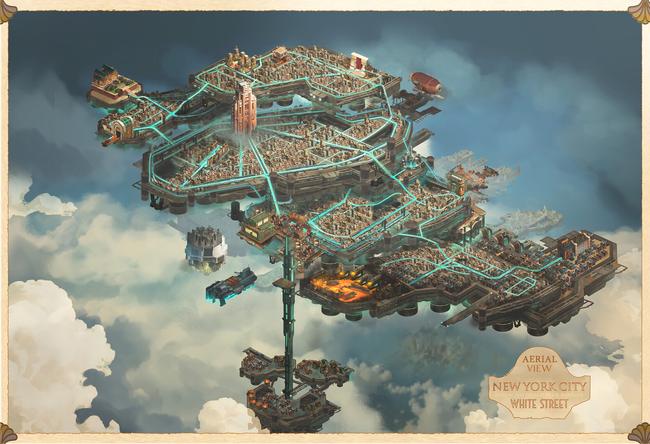
Whitney: We have a… what we’d like to think of as a spectrum of choices. On the low end, you have different ways of navigating conversations. You saw it a few times during your hands-on where you have a choice of how you want to role-play the character or how do you want a conversation to unfold – those are your types of smaller consequences.
Then you go into some moderate choices, in which there’s a diverging point in a mission. Making a certain choice changes a major path, such as “which group do you want to see succeed in this particular thing?” You get to pick that and then you follow that path to see how the world adapts to that decision.
We have a handful of moments in the game where you get to make a pretty substantive decision that affects either a significant portion of the mission is exclusive due to that, or the entire mission itself is mutually exclusive; you pick a branch, and it alters.
Then at the very end, we have game-ending choices. Now how we wanted to approach endings was similar to the Fallout or Witcher games. You have different storylines that are each getting tied up and/or ending all together, because we have so many characters and so many parts of a story that you’ve grown attached to. We can’t tie it up in one bow; it doesn’t feel good, it doesn’t make sense, and it’s a nightmare to write somehow.
What we wanted to do was that depending on the choices you’ve made surrounding individual characters and plot points, they’ll provide you with a different ending for that particular thing – so you get to see the different storylines that you’ve invested in, and maybe there’s a few that you just didn’t care for. You get to see how they all get tied up in their own way towards the end that affect the city in their own way.
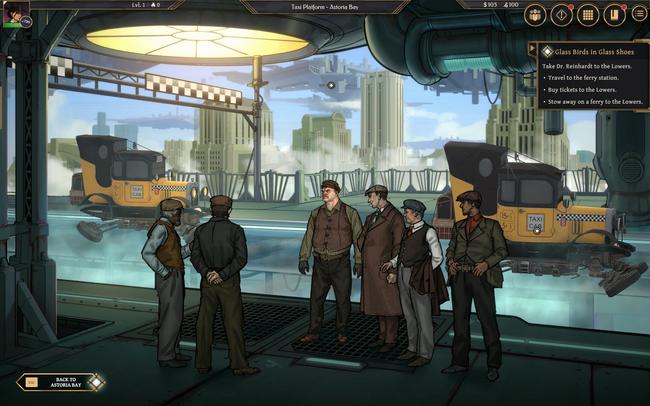
Whitney: The characters that we took the most liberty with are those central characters. Even though I just talked about history, you picked the two characters that we wanted to play with. We wanted to play with the historical tropes of the time. Gia comes from reading Philip Marlowe and other hard-boiled detective stories from the 1940s; they portray the concept of a detective in a very particular way – grizzled, haunted, gone through some stuff, probably has a drinking problem, solves mysteries, gets the girl, and all that stuff.
For Gia, we wanted to take that representation that you find everywhere from that time period and make it our own. We wanted to add depth, complexity, and a new take that would fit our world. If we take that character and they grew up here, how would they be different? A significant portion of Gia’s storyline is reconciling with her past – where she’s come from and how her upbringing in this world has shaped and affected her.
For Nellie, we wanted to do a similar thing akin to a mad scientist that you find in a lot of pulp. We had a lot of fun creating her because if you look at how mad scientists are depicted in that older stuff, they are designed in a very particular way. It’s usually an older guy that’s detached from the world that usually doesn’t have an emotional core or if they do, it’s usually weird, gnarled, or what not. They don’t really have a healthy relationship with anything in the natural order or other people at all. So, we took a look at that and said let’s take that and breathe some life into that archetype that you can find everywhere. That’s how we put together Nellie.
Beyond them, I also want to mention several other characters. Mr. Blanc is based off of a famous South African explorer at the time; if you solder some subtle details in the glass cage where you find him, you can start to gather some of the historical influence as you encounter him more and more. With Cress, we turned to the Black Rosies, black mechanics, for inspiration.
One of my favorite characters that people will meet is based off of a figure known as the Pirate Queen of New York. In the 19th century, there was this Irish woman who was down on her luck and became a criminal. She finds herself surrounded by river pirates and told them to make her their leader because she declared that she was smarter and tougher than them. This is was the era when pirate literature was coming out, so she starts talking like a pirate, treating her crew like a pirate, dressing a pirate, made people walk the plank, and so forth. She goes up and down the East River raiding.
So of course, my immediate reaction is that’s an amazing person to have existed and of course, that’s only half the story because I’m trying to keep this brief. Once again, we took her story and imbue a little bit of that into a character in Aether & Iron that’s heavily inspired by her. We have stuff like that all over the place. If anything, it’s just a lot of fun in reading about these stories of people that existed and lived adventurous lives that impacted so much that we’ve lost, forgotten, or don’t study as much. They existed; they were there, so let’s make it accessible and bring it to people. Let’s show people this amazing history.
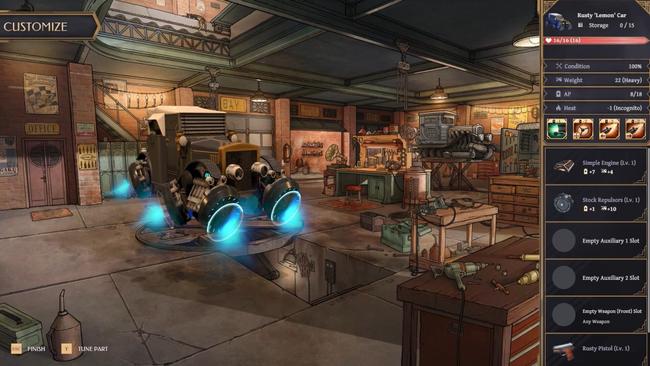
Whitney: Excellent question. Where we looked to allow this expression stems from my love for The Witcher 3. I loved how Geralt was given an opportunity to manifest his personality in different ways and it still felt like him. We took inspiration in that Gia is a smuggler and she is a part of the criminal underworld. She is somebody that’s had to scrap to survive, so she is somebody that is confident, knowledgeable, and brave. While we find her in a cynical and darker place on her back foot, her livelihood has created a version of her that is that rogueish smuggler.
When we’re making choices on how to manifest it, the different skill checks that you make are ways that can manifest – ways that her upbringing and her occupation has allowed her to act in different ways. When we give the player different opportunities for Gia to roleplay outside of that, it’s going to look attached to her character arc. Gia specifically is coming from a place where she is becoming… the word we use is “complacent.” A lot of people in her world are entirely complacent to the dystopian nature they find themselves in.
Life is not pleasant in a lot of these places. We try to find the little pieces of joy in order to illuminate it, but in order to deal with that kind of darkness, a lot of people just grow to not care. “I’m just going to keep my head down and ignore it.” Gia is suffering from that growing sentiment pretty largely of “why should I care ”, “what’s in it for me”, “I’m just going to get burned probably”, and so forth. Throughout Aether & Iron, the player has an opportunity to either buy into that philosophy or they can fight back and try to move forward. While we do kinda nudge the player to lean that way, they don’t have to buy into it. People can still keep that smuggler attitude.
Whitney: What I hope to leave people with is the vision of “why are we making this game?” There are thousands of games coming out constantly. People are inundated and flooded; their attentions are taken to all sorts of places. If someone wants to play our game, we’d be honored. Of course we love the narrative and the gameplay, but I think the reason we do this is for the people behind it.
The games that we played growing up, the ones that really stuck with us… the reason that they did is because of the worlds that they created and it was all we thought about. We were still mentally playing it whether we were in school, on the computer, at recess, or driving. When you’re stuck in the shower and you’re just thinking about it.
The first time I played Bioshock, I only played a few hours and didn’t pick it up again for years, but that game’s world stuck with me. I still thought about it. The “why we do this” is that we hope that when people walk away after playing Aether & Iron, we hope that they’re still mentally stuck in its world, making their own stories, thinking about what they would do, how they would survive, and how they would live. That would be what we’re shooting for.